Although there is a lot of mud around here, Yellowstone’,s Mud Volcano is actually labled wrong. It is not a mud vulcano, but rather a mud pot. The differences between the two features are huge, as a matter of fact, there aren’t any mud volcanoes in the USA except for two in Alaska and a small field in southern California. Although mud pots are often called "mud volcanoes", true mud volcanoes are very different in nature. Read more about them at Wikipedia.
The thermal features in the Mud Volcano area are primarily mud pots and steam vents because the area is situated on a parched water system with little water available.
Steam vents occur when the ground water boils away faster than it can be recharged. Also, the vapors are rich in sulfuric acid that leaches the rock, breaking it down into clay. Because no water washes away the acid or leached rock, it remains as sticky clay to form a mud pot.
A mud pot is a hot spring formed in high-temperature geothermal areas where water is in short supply. The little water that is available rises to the surface at a spot where the soil is rich in volcanic ash, clay and other fine particulates. The thickness of the mud usually changes along with seasonal changes in the water table. The mud takes the form of a viscous, often bubbling, slurry. As the boiling mud is often squirted over the brims of the mud pot, a sort of mini-volcano or "mud volcano" starts to build up, sometimes reaching heights of 3-5 feet.
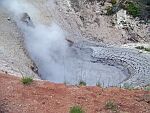 |
Mud Volcano, the feature that named the entire area is only a short walk from the parking lot.
Early explorers to Yellowstone described this feature as a "most repulsive and terrifying sight", a volcano-like cone, 30 feet high and 30 feet wide with mud erupting to cover tall trees. Later visitors only noticed "a seething, bubbling mass of mud." Most likely, a violent eruption blew out the cone’s side, leaving the crater as we can see it today.
Click here (1,
2,
3) for more pictures.
|
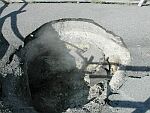 |
Parking Lot Pool is a great example for the volatility of the area. In 1999, a wisp of steam appeared in the parking lot. Asphalt was peeled back to reveal a sunken pool. It is now covered with sand, but we found a picture showing what it once looked like.
Click here for large picture.
|
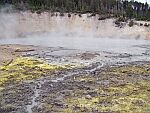 |
Mud Caldron is the first feature you see from the parking lot. Imagine cracks or a natural plumbing system reaching down several thousand feet below Mud Caldron to a source of hot water. Steam produced by this boiling water rises to the surface and passes through Mud Caldron, heating the water in the proces – but not boiling it. The bubbling is caused by carbon dioxide and other gases rising from below.
Click here for large picture.
|
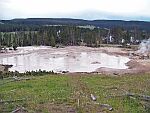 |
Mud Geyser was the star attraction of the Mud Volcano Area when first seen by members of the Washburn expedition in 1870. They described it as "a boiling spring, a placid pond, a a deep dry funnel or an active geyser according to the time of one’s visit." At that time, muddy water would explode 50 feet into the air every few hours. The geyser died in the 20th century, its plumbing clogged with mud and gravel.
In 1993, soil temperatures skyrocketed for unknown reasons and trees began dying around the geyser’s south rim. By 1995, a new feature on the south bank of Mud Geyser had burst onto the scene. In 1999, mudpods formed and then ecploded, leaving a deep hole with more sizzling features and mud.
Click here for large picture.
|
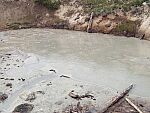 |
Sizzling Basin got its name because until the 1960s there was a vigorous release of gases here- like that from a hot, grease-filled frying pan. During the 1970s, this pool had cooled and lost enough of its carbon dioxide supply to allow a thick, lush mat of microorganisms to cover most of its surface. They were killed when a swarm of earthquakes struck the area in 1978-79 and superheated the water.
Click here for large picture.
|
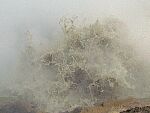 |
Churning Caldron’s history is similar to that of Sizzling Basin. Imagine this frothing pool as a cooler spring covered with colorful mats of microorganisms. That’s what it looked like until earthquakes in 1978-79 superheated the water and killed the microbes. This once cool pool now averages 164°F and in 1996, it began throwing water 3-5 feet.
Click here (1,
2) for more pictures.
|
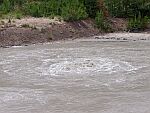 |
Black Dragon’s Caldron burst onto the landscape in 1948 along a crack in the earth. It uprooted and coated nearby trees in thick mud. This feature has since shifted south 200 feet along the crack. The spring feeding nearby Sour Lake was much more active before Black Dragon’s Caldron formed. Perhaps underground changes diverted heat energy from Sour Lake to form this seething mass of mud, which a park ranger named for its color and the apparent lashing of the "dragon’s tongue."
Click here (1,
2) for more pictures.
|
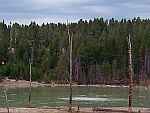 |
Sour Lake, named for its acidic, or “sour” water, may look like a pleasant swimming hole, but its water would burn your skin like battery acid. Most of its acid comes from microorganisms that create sulfuric acid as they consume sulfur. These microbes also give the lake its color.
Click here for large picture.
|
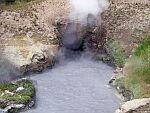 |
Dragon’s Mouth Spring has captured imagination for centuries. The Crow saw the steam as snorts of an angry bull bison. An unknown European American gave it its current name. Its previous names have included Gothic Grotto, Blowing Cavern and The Belcher. This surging action has decreased since 1994; no one is sure why. In 1999, more dramatic changes occurred. The water temperature dropped ten degrees and the color changed from green to chalky white.
Click here for large picture.
|